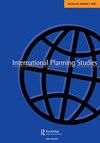Vacant land in London: a planning tool to create land for growth
IF 1.5
Q4 REGIONAL & URBAN PLANNING
引用次数: 10
Abstract
ABSTRACT Vacant land is a widespread urban phenomenon that has been problematised as a waste of a scarce resource, which needs to be brought back to use. The consensus around this belief has been almost unanimous, despite the contradiction between the idea of scarcity and that of vacancy. This paper explores the assumptions underpinning this contradiction to point to new ways of addressing the ‘vacant land problem’. Drawing on the work of Lefebvre and Massey, the paper suggests a dialectical framing of vacant land to understand how its socially constructed nature shapes its transformation. The paper reveals a static understanding of urban change behind the conceptualisation of Battersea Power Station and Silvertown Quays as ‘bad places’, which in turn legitimises and shapes their transformation. The paper argues for a re-problematisation of ‘vacant land’, whereby its function as a planning tool for growth can be challenged.伦敦的空地:为增长创造土地的规划工具
摘要闲置土地是一种普遍存在的城市现象,它被认为是对稀缺资源的浪费,需要重新利用。尽管稀缺性和空缺性之间存在矛盾,但围绕这一信念的共识几乎是一致的。本文探讨了支撑这一矛盾的假设,以指出解决“空地问题”的新方法。本文借鉴列斐伏尔和梅西的作品,提出了一个对空地的辩证框架,以了解其社会建构的性质如何塑造其转变。这篇论文揭示了对巴特西发电站和银城码头概念化背后的城市变化的静态理解,这反过来又使它们的转型合法化并形成了转型。该论文主张将“空地”重新问题化,从而使其作为增长规划工具的功能受到挑战。
本文章由计算机程序翻译,如有差异,请以英文原文为准。
求助全文
约1分钟内获得全文
求助全文
来源期刊

International Planning Studies
REGIONAL & URBAN PLANNING-
CiteScore
4.60
自引率
4.80%
发文量
20
期刊介绍:
Planning, at urban, regional, national and international levels, faces new challenges, notably those related to the growth of globalisation as both an objective socio-economic process and a shift in policy-maker perceptions and modes of analysis. International Planning Studies (IPS) addresses these issues by publishing quality research in a variety of specific fields and from a range of theoretical and normative perspectives, which helps improve understanding of the actual and potential role of planning and planners in this context.
 求助内容:
求助内容: 应助结果提醒方式:
应助结果提醒方式:


